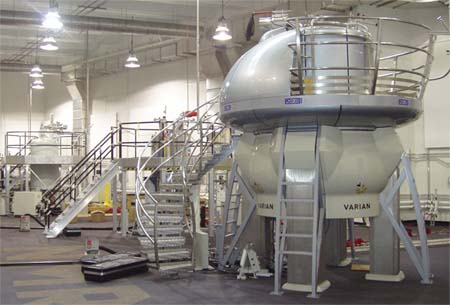
|
Biological Magnetic Resonance Data BankA Repository for Data from NMR Spectroscopy on Proteins, Peptides, Nucleic Acids, and other Biomolecules |
Member of
|
Introduction to Macromolecular NMR Spectroscopy |
||
| ||
|
For many, the most familiar application of Nuclear Magnetic Resonance (NMR) is in Magnetic Resonance Imaging (MRI). An MRI scanner consists of a magnetic field and a radiofrequency transmitter and coil for receiving the signal from the patient. The patient is placed in the magnetic field during data acquisition. Magnetic field gradients are used to encode spatial information in the signal which is used to reconstruct a three-dimensional image of the patient. The same principles are used in NMR applications to chemistry and biochemistry, which actually predated MRI. Biomolecular NMR spectroscopy is the field in which NMR is applied to the molecules present in living organisms. The Biological Magnetic Resonance Data Bank (BMRB) is the publicly accessible repository for NMR data from important biomolecules, such as proteins, nucleic acids, and metabolites. The "N" of NMR refers to atomic nuclei with spin that are magnetically active. The nuclei of greatest interest in biomolecular NMR are all stable (non-radioactive) nuclei. In rough order of importance those studied most frequently are the nuclei from hydrogen-1 (1H), carbon (13C), nitrogen-15 (15N), phosphorus-31 (31P), hydrogen-2 (2H), also known as deuterium), cadmium-113 (113Cd), and fluorine-19 (19F). The "M" of NMR refers to the magnetic field, which is required to set the spinning, magnetically-active nuclei precessing like a gyroscope in the earth's magnetic field. The "R" of NMR refers to resonance, the condition in which the frequency of radio waves used to interact with the sample to be studied matches the precession frequency of one or more nuclei. When this resonance property is fulfilled, energy is transferred, and the state of the nucleus changes. This leads to a signal that can be detected by the scanner or spectrometer. In biomolecular NMR, these signals usually are best detected and resolved at high magnetic fields (9-22 Tesla), and the precession frequencies of nuclei in these fields tend to be in the megahertz (MHz) range.
For a given type of nucleus, the precession frequency is proportional to the strength of the external magnetic field. NMR spectroscopists usually refer to NMR spectrometers with a given magnetic field strength by the precession frequency of the proton (hydrogen-1 nucleus), for example 600 MHz. A nucleus of a given type in a molecule, for example a carbon-13 (13C nucleus), will have a slightly different precession frequency depending on its location in the molecule. The factors that influence the precession frequency are the atoms it is attached to as well as nearby atoms and charges. NMR spectroscopists use the concept of chemical shift to explain the difference in the precession frequency of the nucleus of interest compared to that of a standard reference molecule (for example, the methyl carbon of tetramethyl silane, (13CH3)4Si). Because the difference in precession frequency is proportional to magnetic field, this number is divided by the precession frequency of the reference. The resulting numbers are small and are expressed in parts per million (ppm). In the shorthand notation used, 3.5 ppm is expressed as δ 3.5. The chemical shift is one of the fundamental NMR parameters stored in BMRB. A chemical shift is associated with a particular atom in a defined molecule or complex under defined experimental conditions. If you look through BMRB entries, you will come across other NMR observables that are archived. One of these is the coupling constant J, which arises from interactions between pairs of nuclei that are transmitted through chemical bonds. For example, 1JNH denotes the coupling between a directly bonded (one-bond) 15N-1H pair. In BMRB, the coupled nuclei associated with a particular J are identified along with the description of the molecule and the experimental conditions. Another important NMR observable is the NOE (Nuclear Overhauser Effect). The NOE between two protons is transmitted through space and can provide a measure of the distance between them. As you delve further into NMR, you will appreciate how NMR spectroscopists use combinations of NMR observables extracted from multiple experiments to assign resonance frequencies (peaks in NMR spectra) to individual atoms in the covalent structure of a biomolecule. You will also appreciate how this information can be used to determine the three-dimensional structure (conformation) of proteins and nucleic acids. Kurt Wüthrich, who received the 2002 Nobel Prize in Chemistry for his work in solution-state NMR spectroscopy, explained it like this: Nuclear magnetic resonance (NMR) spectroscopy is unique among the methods available for three-dimensional structure determination of proteins and nucleic acids at atomic resolution, since the NMR data can be recorded in solution. Considering that body fluids such as blood, stomach liquid and saliva are protein solutions where these molecules perform their physiological functions, knowledge of the molecular structures in solution is highly relevant. In the NMR experiments, solution conditions such as the temperature, pH and salt concentration can be adjusted so as to closely mimic a given physiological fluid. Conversely, the solutions may also be changed to quite extreme non-physiological conditions, for example, for studies of protein denaturation. Furthermore, in addition to protein structure determination, NMR applications include investigations of dynamic features of the molecular structures, as well as studies of structural, thermodynamic and kinetic aspects of interac-tions between proteins and other solution components, which may either be other macromolecules or low molecular weight ligands. Again, for these supplementary data it is of keen interest that they can be measured directly in solution.* * Kurt Wüthrich - Nobel Lecture: NMR Studies of Structure and Function of Biological Macromolecules |
